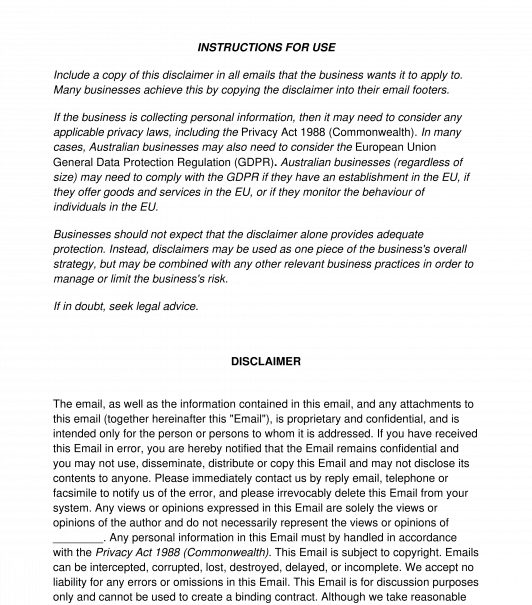 21/04/2025
21/04/2025

Answer a few questions and your document is created automatically.

Your document is ready! You will receive it in Word and PDF formats. You will be able to modify it.

This Email Disclaimer is designed to be placed in the footer of business emails, to notify recipients of the email about how the email (together with its contents and attachments) may be used.
In particular, it notifies people who have received the email in error that the email may contain confidential information and that they must delete the email. It also notifies all recipients that the email only represents the opinions of the sender (and not necessarily those of the business). It advises that the business accepts no liability for losses that result from unauthorised use of the email. Several optional clauses may also be added, including clauses dealing with:
This disclaimer also allows the sender to include various links such as for websites, social media pages and the business's privacy policy.
The legal effectiveness of email disclaimers in Australia is somewhat unclear. Generally speaking, while it does not hurt to include a disclaimer on business emails, the business should not expect that the disclaimer alone provides adequate protection. Instead, disclaimers may be used as one piece of the business's overall strategy, but the business may consider combining the disclaimer with various other practices in order to manage or limit the business's risk.
For example, if the business is handling a confidential information by email, then it should strongly consider using a Confidentiality Agreement. If the business is collecting personal information, it may also need a Privacy Policy.
How to use this email
Include a copy of this disclaimer in all emails that the business wants it to apply to. Many businesses achieve this by copying the disclaimer into their email footers.
Businesses should not expect that the disclaimer alone provides adequate protection. Instead, disclaimers may be used as one piece of the business's overall strategy, but may be combined with any other relevant business practices in order to manage or limit the business's risk.
Applicable law
Depending on the nature of the email correspondence, various areas of Australian law may apply. These may but are not limited to) laws in relation to privacy, (as provided under the Privacy Act 1988 (Commonwealth)), confidentiality, negligence and other torts.
As of 25 May 2018, the European Union General Data Protection Regulation (GDPR) contains new data protection requirements that may apply to Australian businesses.
Australian businesses (regardless of size) may need to comply with the GDPR if they have an establishment in the EU, if they offer goods and services in the EU, or if they monitor the behaviour of individuals in the EU.
This disclaimer does not deal with the GDPR.
Further information about how the GDPR may affect Australian businesses is available through the Office of the Australian Information Commissioner. If in doubt, seek legal advice.
How to modify the template
You fill out a form. The document is created before your eyes as you respond to the questions.
At the end, you receive it in Word and PDF formats. You can modify it and reuse it.
A guide to help you: What Documents do I Need for my Online Business?
Email Disclaimer - sample template - Word and PDF
Country: Australia